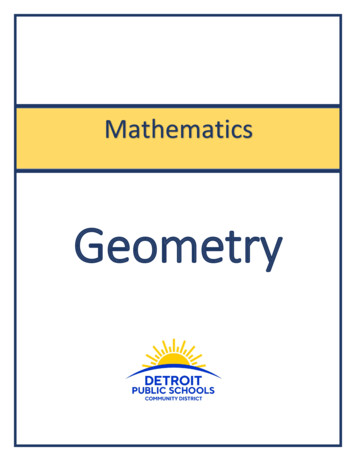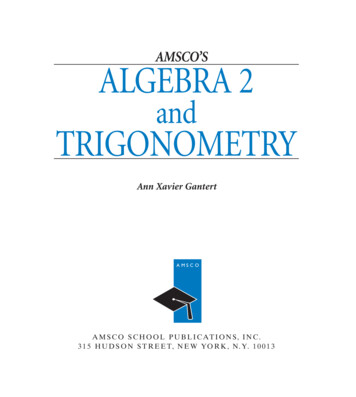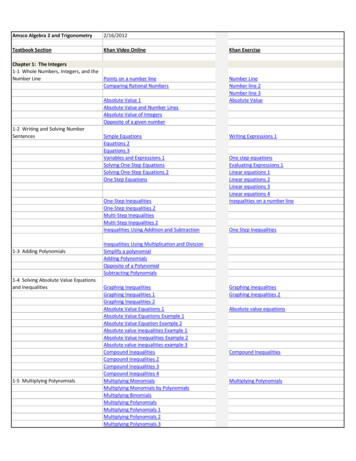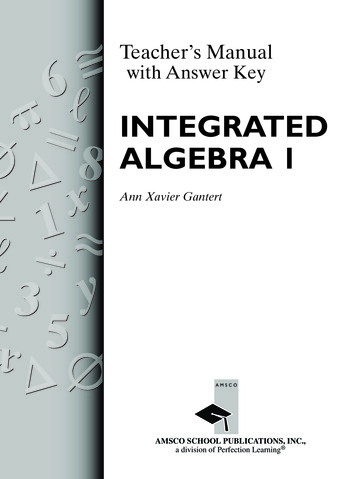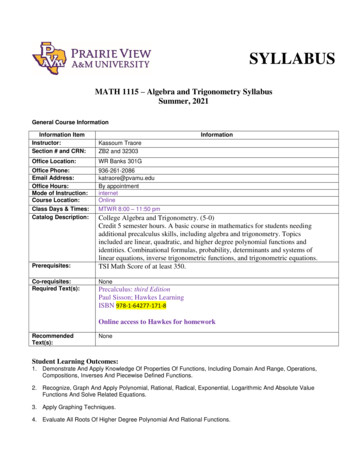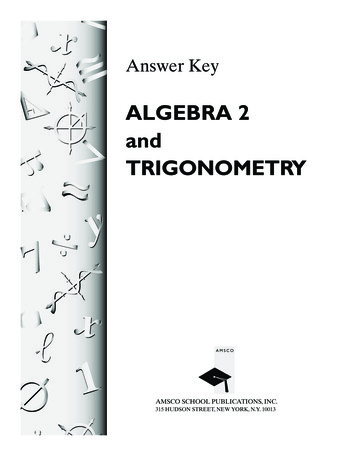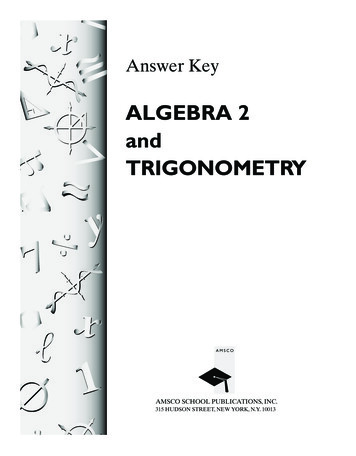
Transcription
Amsco algebra 2 and trigonometry textbook answers pdf free pdf
14580FM.pgs 3/26/09 12:11 PM Page i Teacher’s Manual with Answer Key ALGEBRA 2 and TRIGONOMETRY Marilyn Davis AMSCO AMSCO SCHOOL PUBLICATIONS, INC. 315 HUDSON STREET, NEW YORK, N.Y. 10013 14580FM.pgs 3/26/09 12:11 PM Page ii Author of the Teacher’s Manual Marilyn Davis Math Consultant Portions of this bookwere adapted from the following Amsco Publication: Teacher’s Manual/Mathematics B by Edward P. Keenan, Ann Xavier Gantert, and Isidore Dressler Please visit our Web site at: www.amscopub.com When ordering this book, please specify: N 159 CD or TEACHER’S MANUAL/ALGEBRA 2 AND TRIGONOMETRY ISBN: 978-1-56765-704-3 Copyright 2009 by Amsco School Publications, Inc. No part of this Teacher’s Manual may be reproduced in any form without written permission from the publisher except by those teachers using the AMSCO textbook ALGEBRA 2 AND TRIGONOMETRY, who may reproduce or adapt portions of the manual in limited quantities for classroom use only. Printedin the United States of America 1 2 3 4 5 6 7 8 9 10 14 13 12 11 10 09 14580FM.pgs 3/26/09 12:11 PM Page iii Contents About the Teacher’s Manual v Assessment vi Suggested Time Outlines Chapter 1 2 3 4 5 6 7 8 9 10 11 12 13 14 15 16 The Integers viii 1 The Rational Numbers 17 Real Numbers and Radicals 30 Relations and Functions 45Quadratic Functions and Complex Numbers 63 Sequences and Series 79 Exponential Functions 91 Logarithmic Functions 104 Trigonometric Functions 118 More Trigonometric Functions 133 Graphs of Trigonometric Functions 145 Trigonometric Identities 162 Trigonometric Equations 172 Trigonometric Applications 183 Statistics 199 Probabilityand the Binomial Theorem 217 Summary of Formulas and Trigonometric Relationships 232 Table of Measures 242 Holistic Scoring Rubric 243 Conversion Chart 245 iii 14580FM.pgs 3/26/09 12:11 PM Page iv Contents Answer Keys For Enrichment Activities 246 For Extended Tasks 255 For Suggested Test Items 261 For SAT Preparation Exercises269 For Textbook Exercises iv Chapter 1 271 Chapter 2 274 Chapter 3 277 Chapter 4 282 Chapter 5 291 Chapter 6 299 Chapter 7 303 Chapter 8 308 Chapter 9 312 Chapter 10 319 Chapter 11 324 Chapter 12 334 Chapter 13 343 Chapter 14 345 Chapter 15 349 Chapter 16 359 14580FM.pgs 3/26/09 12:11 PM Page v About the Teacher’s Manual Thismanual parallels the organization of the text and provides: suggestions for assessment. aims for each chapter. commentary on each individual section of the text. leading questions to stimulate classroom discussion. a variety of approaches to promote flexibility in problem solving. suggestions to maximize the effectiveness of specificexamples and exercises. techniques for dealing with difficulties that students may encounter. reproducible Enrichment Activities and suggestions for more challenging aspects of topics in the text. appropriate hands-on activities. suggestions for Extended Tasks and investigations to be undertaken by students. supplementary material thatreflects current thinking in mathematics education. a set of SAT Preparation Exercises for each chapter. questions to form the basis for chapter tests. an answer key for the Enrichment Activities, the Extended Tasks, the Suggested Test Items, the SAT Preparation Exercises, and the text. v 14580FM.pgs 3/26/09 12:11 PM Page vi Assessment Asa student studies the content of the text associated with this manual, it is important that the student, teacher, parents, and administrators have tangible evidence of the student’s progress toward established goals. That evidence can be obtained in a variety of ways. Some of these tangibles, and the features of the student text and teacher’s manualthat can aid in assembling that evidence, are listed. Homework Assignments The need for consistent reflection on and practice with the content of each day’s lesson has always been accepted as a necessary factor in promoting the student’s understanding and skills. Each day’s homework assignment should enable the student and the teacher torecognize progress as well as identify needs. The text provides both routine and challenging exercises at the end of each section for this purpose. Cumulative Reviews Cumulative reviews in the text allow the student to evaluate his/her skills within the format of the Regents Examination in Algebra 2 and Trigonometry. Use the Holistic Scoring Rubricin this manual to provide the student with insight into the number of credits his/her responses merit. Guide the student in formulating responses that will receive full credit on the examination. Measure student progress by scaling cumulative review scores using the Conversion Chart. Portfolio A portfolio is a record of a student’s progress. Theselection of materials to be included in the portfolio presents opportunities for the student to reflect upon what he/she has done, improve faulty work, and take pride in work that is well done and in insightful information that has been gained. Significant examples of homework assignments, tests, and independent research or readings, as well ascompleted Enrichment Activities, Hands-On Activities, Bonus Questions, or Extended Tasks from the student text or this manual, are excellent materials for inclusion. Tests and Quizzes Tests give the student opportunities to demonstrate that he/she understands concepts and has the ability to make use of that understanding. This manual providesSuggested Test Items for each chapter. These questions can be used by the teacher when constructing a test based on the instructional goals established for the class. vi 14580FM.pgs 3/26/09 12:11 PM Page vii Independent and Group Projects Mathematical understanding and enthusiasm are increased by opportunities to explore in-depth topics ofspecial interest to the students. Some of these topics may be suggested by the students themselves. Others are given as Explorations in the Cumulative Reviews of the chapters of the text or as Enrichment Activities in this manual. These Explorations and Activities lend themselves to either individual or group study. Journal A journal can be a usefultool to promote a studied reflection upon day-by-day progress. A journal may be a record of feelings, understandings, fears, insights, and questions. Putting these into words can help students to clarify ideas and identify concepts that need further explanation and exploration. The content of the journal can be the choice of the student, a response to ateacher’s question or prompt, or an explanation based on questions from the Writing About Mathematics section of the exercises. You may ask students to: describe characteristics they have noticed about problems that can be solved using a particular method. explain or justify steps for a computation or proof. explain key properties or conceptsin their own words. write their own problems for a particular concept or method. explain the possible results for a given situation (such as solving a quadratic equation). give examples of how certain concepts are applied in the real world. explain how they organized their work for more complex Applying Skills problems. create a flowchart orother diagram for solving a particular problem. explain why a given answer must be incorrect based on properties, number sense, or estimation. explain why they chose one method of proof rather than another. make a list of common errors they must watch for in their own work. vii 14580FM.pgs 3/26/09 12:11 PM Page viii Suggested TimeOutlines Since teaching from a new text can create time problems, the timetable below is offered to assist you in planning your work. If a state or national test is given before the end of the school year, it may be difficult to cover the content for the year before the test is administered. To use time most effectively, check if any of the lessons will not betested. Consider skipping non-tested lessons and returning to them after the test. You may also wish to identify lessons that are predominantly review of concepts from an earlier grade and reduce the amount of class dedicated to these lessons by assigning them as homework only. CHAPTER 1 2 3 4 5 6 7 8 9 10 11 12 13 14 15 16 1 Year 1.5 Years 2Years Days Days Days The Integers 4–5 10–12 15–16 The Rational Numbers 4–5 10 15–16 Real Numbers and Radicals 4–6 10–11 15–16 Relations and Functions 13–15 19–20 25–26 Quadratic Functions and Complex Numbers 13–15 19–20 25–26 Sequences and Series 13–15 15–20 24–25 Exponential Functions 12–14 17–20 22–24 Logarithmic Functions12–14 17–20 22–24 Trigonometric Functions 13–15 19–20 24–25 More Trigonometric Functions 8–9 15 20–22 Graphs of Trigonometric Functions 8–9 15 20–22 Trigonometric Identities 12–14 18–20 23–25 Trigonometric Equations 12–14 16–21 23–25 Trigonometric Applications 9–10 15–16 20–22 Statistics 9–10 15 22–24 Probability and the BinomialTheorem 9–10 15 20–22 155–180 245–270 335–360 Total viii 14580TM C01.pgs 3/26/09 12:11 PM Page 1 CHAPTER 1 THE INTEGERS Aims To review operations and properties of integers. To perform operations with polynomial expressions. To solve absolute value equations and inequalities. To factor polynomial expressions. To solvequadratic equations and inequalities by factoring. This chapter reviews properties and skills that should be familiar to students from previous mathematics courses. Integer solutions to all exercises in this chapter provide a built-in check for students looking to refresh their skills. Factoring is essential for success in algebra, and since the process offactoring reverses the process of multiplication, multiplication of polynomials is reviewed before factoring is explored. Factoring is applied to solve quadratic equations and inequalities. The procedure for inequalities will be new for many students and the need to consider the signs of the factors should be discussed in depth. CHAPTER OPENER In thegolf example, par is equivalent to zero on a number line, that is, the reference point from which distances above and below are determined. Rosie’s standing is found by evaluating the expression 22 1 (22) 1 1 5 23 or 3 below par for the course. Nancy’s standing is 21 1 (21) 1 (21) 5 23, so she is also 3 below par. If par is 100 strokes, then both playersshot 97. If par is 95 strokes, then both players shot 92. 1-1 WHOLE NUMBERS, INTEGERS, AND THE NUMBER LINE The number line, introduced with the set of counting numbers, is extended to include 0 and then all of the integers. Basic concepts including opposites, subtraction, and absolute value are reviewed. Emphasize that 2a means “theopposite of a,” and that the opposite of a negative number is a positive number. For Exercise 2, students can write b 2 a 5 2(a 2 b). Using substitution, a 2 b 5 2(a 2 b) , so a 2 b 5 b 2 a . 1-2 WRITING AND SOLVING NUMBER SENTENCES Properties of equality and inequality are reviewed and applied to solve problems. Emphasize that to maintain theorder of inequality when multiplying or dividing an inequality by some number c, c must be posi- 1 14580TM C01.pgs 2 3/26/09 12:11 PM Page 2 Chapter 1 tive. Illustrate this multiplication and division property of inequality as follows. Given: 7 . 4 Let c 5 0. Is 7(0) . 4(0) or 0 . 0? No; 0 5 0. Given: 7 . 4 Let c 5 25. Is 7(25) . 4(25) or 235 . 220? No; 235 ,20. The examples will help students to remember to reverse the inequality when multiplying or dividing by a negative number. Example 2 illustrates the approach needed to solve an equation involving absolute value. If 6x 2 3 5 u, then the equation becomes u 5 15 and, by definition, u can equal either 15 or 215. This is the source of the two derivedequations. When solving absolute value equations, students should be aware that the absolute value term has to be alone on one side of the equation. For example, the steps for solving 2x 1 3 2 4 5 7 are: 2x 1 3 2 4 5 7 2x 1 3 2 4 1 4 5 7 1 4 2x 1 3 5 11 2x1 3 5 11 2x1 323 5112 3 2x1 3 5 211 or 2x1 323 5 2112 3 2x 5 8 2x 5 214 x54 2x 5 27 Ask studentsif 3x 2 8 5 25 has a solution. (No; 3x 2 8 represents some number and absolute value cannot be negative.) 1-3 ADDING POLYNOMIALS When reviewing the addition of polynomials in this section, address common errors that students make, such as writing 3x2 2 x2 5 3 or failing to write the opposite of each term in an expression being subtracted.Have students recall the distributive property as they work with expressions: 3x2 2 x2 5 3x2 2 1x2 5 (3 2 1)x2 5 2x2 2(4c3 2 2c2 1 5) 5 2(4c3) 2 (22c2) 2 (5) 5 24c3 1 2c2 2 5 For Exercise 25, the solution is found by using cents to represent the values of the coins and the toll. If x is the number of quarters, then x 1 3 is the number of dimes and 25x 510(x 1 3). 1-4 SOLVING ABSOLUTE VALUE EQUATIONS AND INEQUALITIES To isolate the absolute value expression in an equation, the same steps are used as for isolating a variable. During this process, the absolute value expression is treated as a single entity. To help students see the form, let A represent 4a 1 2 so that 4a 1 2 1 7 5 21 becomesA 1 7 5 21. The quantity A must be isolated before the equation can be solved, so A 1 7 2 7 5 21 2 7 and A 5 14. Call attention to the fact that an absolute value inequality of the form x 2 a 5 k, k . 0, has two solutions that separate the number line into three regions: The graph of the solution set of x 2 a , k is the portion of the number line between thesolutions of x 2 a 5 k; the graph of the solution set of x 2 a . k is the union of the other two regions, that is, the portion of the number line to the left of the smaller solution and the portion of the number line to the right of the larger solution. To summarize for students, explain that to solve an absolute value inequality, you must change from absolutevalue to plain inequality. The way to handle the change depends on which direction the inequality points with respect to the absolute-value term. To solve for x: If ax 1 b * c, solve 2c * ax 1 b * c. If ax 1 b c, solve ax 1 b c and ax 1 b * 2c. For Exercise 29, be sure students understand that “as much as” means “less than or equal to” or “no morethan.” 200 2 c # 28 14580TM C01.pgs 3/26/09 12:11 PM Page 3 The Integers 1-5 MULTIPLYING POLYNOMIALS 1-6 When a polynomial is multiplied by a polynomial, each term of the first factor is multiplied by each term of the second factor. Thus, when multiplying a binomial by a binomial, there are 2 3 2 5 4 multiplications. The product, insimplest form, has four terms when no two terms of the product are like terms: (3a 2 1)(2b 1 1) 5 6ab 1 3a 2 2b 2 1 The product, in simplest form, has three terms when two terms of the product are like terms: (3a 2 1)(4a 1 1) 5 12a2 1 3a 2 4a 2 1 5 12a2 2 a 2 1 The product, in simplest form, has two terms when two terms of the product are opposites:2. Keep in mind that the difference of two squares is the only binomial form that can be factored into two binomials. If the factoring is to be done with respect to the set of integers, the squares must be the squares of integers or even powers of the variables. 3. To factor a trinomial into binomial factors, write the terms of the trinomial in order ofdescending or ascending powers of the variables. ax2 (b) 5 2bx(2ax) a2 1 a 2 3 3a3 1 3a2 2 9a 2a2(a2 1 a 2 3) 5 2a4 1 2a3 2 6a2 3 1. Always look for a common monomial factor first. 2 a2 2 a 1 3 Suggest that to multiply a polynomial by a polynomial, students write each polynomial in standard form, that is, in descending order according to the valuesof their exponents. Some students may benefit from using the vertical form of multiplication, writing similar terms one under the other. For example, 4 To factor efficiently, students must understand the use of the distributive property in the multiplication of polynomials. Emphasize the following: 3 2a2 1 3a 2 1 5 9a2 2 4 3a(a2 1 a 2 3) 5 FACTORINGPOLYNOMIALS Example 2 illustrates the technique of factoring by grouping, which may be useful when four or more terms are given. To group, we take the terms two at a time and look for common factors for each of the pairs on an individual basis. Factoring by grouping works only if a new common factor appears, the exact same one in each term.As noted in the text, a polynomial of four terms can be factored into two binomials if the product of the first and last terms equals the product of the two middle terms. For example, in the polynomial ax2 2 bx 2 ax 1 b: (3a 1 2)(3a 2 2) 5 9a2 1 6a 2 6a 2 4 21(a2 1 a 2 3) 5 3 2 2a 1 5a 2 4a 2 10a 1 3 In Enrichment Activity 1-5: On the Ins and Outs,students use products of polynomials to analyze a number pattern and then use algebra to generalize the pattern. ? abx2 5 abx2 However, the pairs of terms ax2 2 bx and 2ax 1 b do not yield a common binomial factor. We must change the order of the middle terms. ax2 2 ax 2 bx 1 b 5 ax(x 2 1) 2 b(x 2 1) 5 (x 2 1)(ax 2 b) Factoring is an oppositeoperation of multiplication. Therefore, we can factor a trinomial into the product of two binomials by reversing the steps of the multiplication process. 14580TM C01.pgs 4 3/26/09 12:11 PM Page 4 Chapter 1 Multiplication: (2x 2 3)(3x 1 5) 5 2x(3x 1 5) 2 3(3x 1 5) degree polynomials and provides additional practice that leads to a general formula fordetermining the sum and difference of two cubes. 5 6x2 1 10x 2 9x 2 15 5 6x2 1 x 2 15 1-7 Factoring: 6x2 1 x 2 15 5 6x2 1 10x 2 9x 2 15 5 2x(3x 1 5) 2 3(3x 1 5) 5 (3x 1 5)(2x 2 3) Note that the only step that is not easily reversed is the last step in the multiplication. There is a unique sum of 10x and 29x, but there is not a unique way of writing 1x asthe sum of two terms. To choose the correct pair of terms, we must observe that the product 6x2(215) is the same as the product 10x(29x). Therefore, the first step of this factoring method is to find two terms whose sum is the middle term and whose product is the same as the product of the first and last terms. Method 2 presents the approach thatuses checking pairs of factors. Students may find these tips helpful: 1. If the last term of the trinomial is positive, the two binomials contain the same operation. If the middle term is positive, the two binomials each contain addition as their operation. If the middle term is negative, the two binomials each contain subtraction as their operation. 2.When the last term of the trinomial is negative, the binomials have opposite operations. In Exercises 37 and 38, suggest that students substitute P for the expression in parentheses to identify the factoring technique. Factor in terms of P, then substitute and simplify. Enrichment Activity 1-6: Factoring the Sum and Difference of Two Cubes applies themethod of finding a binomial factor to higher- QUADRATIC EQUATIONS WITH INTEGRAL ROOTS The procedure for solving a quadratic equation by factoring rests on the multiplication property of 0, which allows us to apply the principle ab 5 0 if and only if a 5 0 or b 5 0. Students may sometimes try incorrectly to apply the principle in solving anequation such as x2 2 6x 5 7 by factoring to get x(x 2 6) 5 7, and then setting each factor equal to 7. Emphasize that in order to apply the principle, one side of the equation must be 0. Thus, the first step in solving a quadratic equation is to remove all terms from one side of the equation. Then, combine all like terms before factoring. Point out thatwhen solving an equation whose highest-power term has a negative coefficient, we generally make it positive by multiplying both sides of the equation by 21. This makes the factoring process easier. For example: 2x2 1 5x 1 6 5 0 21(2x2 1 5x 1 6) 5 21 ? 0 x2 2 5x 2 6 5 0 (x 2 6)(x 1 1) 5 0 x–650 x56 x1150 x 5 21 The numbers 6 and 21 both satisfy theoriginal equation 2x2 1 5x 1 6 5 0. In Examples 2 and 3, point out that since the 2 that was factored out is an expression not containing a variable, we do not have to set it equal to zero. In Exercise 2, students are asked to justify the extension of the zero-factor property to three factors. 14580TM C01.pgs 3/26/09 12:11 PM Page 5 The Integers 1-8QUADRATIC INEQUALITIES When a quadratic inequality is solved algebraically by factoring, two cases must always be considered. If the product is positive (. 0), then the factors are either both positive or both negative. If the product is negative (, 0), then either the first factor is negative and the second factor is positive or the first factor is positiveand the second factor is negative. If (ax 1 b)(cx 1 d) . 0, then: (ax 1 b) , 0 and (cx 1 d) , 0 or (ax 1 b) . 0 and (cx 1 d) . 0. If (ax 1 b)(cx 1 d) , 0, then: 2(ax 1 b) , 0 and (cx 1 d) . 0 or (ax 1 b) . 0 and (cx 1 d) , 0. Another common method of finding the solution set of a quadratic inequality is to indicate the signs of the factors of the polynomial using a numberline. The sign graph for the inequality x2 2 2x 2 15 , 0 of Example 1 is shown below. The sign of each factor in each interval is considered. (x 2 5) (x 1 3) 23 5 2 2 2 2 2 2 2 2 2 0 1 1 2 0 1 1 1 1 1 1 1 1 1 1 The product is negative if one factor is negative and one factor is positive. The graph shows this to be the case for 23 , x , 5. Graphing quadraticinequalities on the coordinate plane and determining the solutions from the graphs will be examined in Chapter 5. Have students practice solving quadratic inequalities using their calculators. Note that the inequality symbols can also be entered from the TEST menu. 5 EXTENDED TASK For the Teacher: This task is intended to reinforce students’understanding of distance and absolute value. The definition of “walking distance” models distance in a city with a grid of perpendicular streets and dense construction that does not allow for diagonal shortcuts. Students may need to review the midpoint and distance formulas and the property of the perpendicular bisector of a segment. SATPREPARATION EXERCISES Students should be given experience that will promote ease in dealing with unusual problems presented in a variety of ways, thus increasing their chances for success in standardized testing. This experience should be made available throughout the students’ mathematics education. In keeping with the philosophy that theclassroom teacher is uniquely qualified to offer such training on an ongoing basis, this Teacher’s Manual provides a set of SAT Preparation Exercises for each of the 16 chapters of the book. These exercises, which are of the type and level of difficulty students will encounter in actual SATs, include Multiple-Choice and Student-Produced ResponseQuestions. Each set of problems reflects the basic concepts of the chapter, but many of these problems are quite challenging. Students may be asked to attempt individually to solve two or three problems each night, or students may work in groups. No matter how these problems are assigned, students should not be discouraged if they find them tobe difficult. In time, students will begin to learn how to approach these exercises and how to find correct solutions. Teachers may wish to adapt the following answer sheet for use with the SAT Preparation Exercises to provide students with practice gridding answers. 14580TM C01.pgs 6 3/26/09 12:11 PM Page 6 Chapter 1 SUGGESTED TEST ITEMSA set of test questions is provided in this Teacher’s Manual for each chapter of the text. Because of the variables in testing situations, such as the ability level of a class and the length of a class period, these sets of questions need not be used as formal tests. However, they are formatted as such to be readily reproducible. The Bonus items vary innature, some requiring special insight into text material, others needing a fresh and unorthodox approach to problem solving. Students should have the opportunity to work on these problems outside of class. 14580TM C01.pgs 3/26/09 12:11 PM Page 7 Name Class Date Answer Sheet SAT Preparation Exercises (Chapter ) Use a No. 2 pencil. Fillin the circle completely. If you erase, erase completely. Incomplete erasures may be read as answers. I. MULTIPLE-CHOICE QUESTIONS A B C D E A B C D E A B C D E A B C D E A B C D E A B C D E A B C D E A B C D E A B C D E A B C D E A B C D E A B C D E A B C D E A B C D E A B C D E A B C D E A B C D E A B C D E A B C D E A B C D E II.STUDENT-PRODUCED RESPONSE QUESTIONS / / . . . / / . . . / / . . . / / . . . 0 0 0 0 0 0 0 0 0 0 0 0 1 1 1 1 2 2 2 2 1 1 1 1 2 2 2 2 1 1 1 1 2 2 2 2 1 1 1 1 2 2 2 2 3 3 3 3 3 3 3 3 3 3 3 3 3 3 3 4 4 4 4 4 4 4 4 4 4 4 4 4 4 5 5 5 5 5 5 5 5 5 5 5 5 5 6 6 6 6 6 6 6 6 6 6 6 6 7 7 7 7 7 7 7 7 7 7 7 8 8 8 8 8 8 8 8 8 8 9 9 9 9 9 9 9 9 9 / / . . . . / / . . . . 0 0 0 0 0 0 1 1 1 1 2 444444455555555666666667777777788888 8 8 8 9 9 9 9 9 9 9 9 Copyright 2009 by Amsco School Publications, Inc. . . . . 0 0 0 1 1 1 1 2 2 2 2 3 3 3 3 3 4 4 4 4 4 4 5 5 5 5 5 5 5 6 6 6 6 6 6 6 6 7 7 7 7 7 7 7 7 7 8 8 8 8 8 8 8 8 8 8 9 9 9 9 9 9 9 9 9 9 14580TM C01.pgs 3/26/09 12:11 PM Page 8 Name Class Date ENRICHMENT ACTIVITY 1-5 On the Ins and Outs Look at this sequence ofconsecutive integers: 4, 5, 6, 7 The product O of the outside pair is 4 3 7 5 28. The product I of the inside pair is 5 3 6 5 30. The difference between the inside product and the outside product is I 2 O 5 2. 1. Find I 2 O for each of these sequences. a. 9, 10, 11, 12 b. 18, 19, 20, 21 c. 30, 30 1 1, 30 1 2, 30 1 3 d. x, x 1 1, x 1 2, x 1 3 2. What pattern did youobserve in Exercise 1? 3. Find I 2 O for each of these sequences. a. 7, 10, 13, 16 b. 20, 23, 26, 29 c. 101, 104, 107, 110 d. x, x 1 3, x 1 6, x 1 9 4. What pattern did you observe in Exercise 3? 5. What pattern would you expect to see in the differences of inside and outside products for numbers that differ by 4? 6. Find I 2 O for each of these sequences. a.x, x 1 2, x 1 4, x 1 6 b. x, x 1 5, x 1 10, x 1 15 c. x, x 1 6, x 1 2(6), x 1 3(6) d. x, x 1 k, x 1 2k, x 1 3k 7. Using the answer to Exercise 6d, explain how the difference between the inside and outside products is related to the numbers in the sequence. 8. If the difference between the inside and outside product is 162, what is the difference betweenconsecutive terms? Copyright 2009 by Amsco School Publications, Inc. 14580TM C01.pgs 3/26/09 12:11 PM Page 9 Name Class Date ENRICHMENT ACTIVITY 1-6 Factoring the Sum and Difference of Two Cubes We know that when the sum and the difference of the same two terms are multiplied, the product is a binomial because two of the termsof the product have a sum of 0. For example: (2x 1 5)(2x 2 5) 5 4x2 2 10x 1 10x 2 25 5 4x2 2 25 In a similar way, the product of a binomial and a trinomial whose product has six terms can be written as a binomial when two pairs of similar terms have a sum of 0. For example: (x 1 2)(x2 2 2x 1 4) 5 x3 2 2x2 1 4x 1 2x2 2 4x 1 8 5 x3 1 8 We notice that theproduct is the sum of two cubes: x3 is the cube of x and 8 is the cube of 2. In two of the terms whose sum is 0, 2 and 22 are the coefficients of x2, and 4 and 24 (the square of 2 and its opposite) are the coefficients of x. The pattern that we observe in the product shown above can help us to factor both the sum of two cubes and the difference of twocubes. Example Factor x3 1 27. Method 1 1. Since 27 is the cube of 3, use 3 and 23 as the coefficients of x2, and 9 and 29 as the coefficients of x: x3 1 27 5 x3 2 3x2 1 9x 1 3x2 2 9x 1 27 2. Factor out the greatest common factor of each group of three terms: x3 1 27 5 x3 2 3x2 1 9x 1 3x2 2 9x 1 27 5 x(x2 2 3x 1 9) 1 3(x2 2 3x 1 9) 3. Factor out thecommon trinomial factor (x2 2 3x 1 9): x3 1 27 5 x3 2 3x2 1 9x 1 3x2 2 9x 1 27 5 x(x2 2 3x 1 9) 1 3(x2 2 3x 1 9) 5 (x2 2 3x 1 9)(x 1 3) Copyright 2009 by Amsco School Publications, Inc. 14580TM C01.pgs 3/26/09 12:11 PM Page 10 Name Class Date Method 2 1. Again, use 3 and 23 as the coefficients of x2, and 9 and 29 as the coefficients of x, butarrange the terms in a different order: x3 1 27 5 x3 1 3x2 2 3x2 2 9x 1 9x 1 27 2. Factor out the greatest common factor of each pair of terms: x3 1 27 5 x3 1 3x2 2 3x2 2 9x 1 9x 1 27 5 x2(x 1 3) 2 3x(x 1 3) 1 9(x 1 3) 3. Factor out the common binomial factor (x 1 3): x3 1 27 5 x3 1 3x2 2 3x2 2 9x 1 9x 1 27 5 x2(x 1 3) 2 3x(x 1 3) 1 9(x 1 3) 5 (x 1 3)(x2 23x 1 9) The difference of two cubes can be factored in a similar way. Exercises In 1–5, factor each binomial. 1. x3 2 8 5 x3 2 23 5 x3 2 2x2 1 2x2 2 4x 1 4x 2 8 2. x3 1 64 5 x3 1 43 5 x3 1 4x2 2 4x2 2 16x 1 16x 1 64 3. x3 2 64 5 x3 2 43 5 x3 2 4x2 1 4x2 2 16x 1 16x 2 64 4. x3 1 125 5 x3 1 53 5 x3 1 5x2 2 5x2 2 25x 1 25x 1 125 5. x3 2 8y3 5 x3 2 (2y)3 5 x32 x2(2y) 1 x2(2y) 2 x(2y)2 1 x(2y)2 2 (2y)3 6. Derive a pattern for the factors of a3 1 b3. 7. Derive a pattern for the factors of a3 2 b3. In 8–11, use the patterns derived in Exercises 6 and 7 to factor each binomial. 8. 8x3 1 y3 9. x3 2 8y3 10. 125 2 27d3 11. 64x3 1 27y3 12. Factor a4 2 b4 5 a4 2 a3b 1 a3b 2 a2b2 1 a2b2 2 ab3 1 ab3 2 b4 by first findingthe common factor of each pair of terms. Use the same method to factor the resulting polynomial factor of four terms. 13. Use the factors of the difference of two squares twice to factor a4 2 b4. Copyright 2009 by Amsco School Publications, Inc. 14580TM C01.pgs 3/26/09 12:11 PM Page 11 Name Class Date EXTENDED TASK Going for a WalkAssume the walking distance between two points on the coordinate plane is the length of the shortest path between the points that consists only of horizontal and vertical segments. 1. Find at least three ways to travel from (1, 1) to (7, 5). What is the walking distance for each? 2. Find the walking distance between each pair of points. a. (2, 3) and (11,9) b. (25, 0) and (8, 26) c. (1, 27) and (14, 215) 3. a. Find all the integral points that are a walking distance of 6 units from the point (6, 6). Graph the points. b. If all the
Amsco algebra 2 and trigonometry textbook answers pdf free pdf 14580FM.pgs 3/26/09 12:11 PM Page i Teacher's Manual with Answer Key ALGEBRA 2 and TRIGONOMETRY Marilyn Davis AMSCO AMSCO SCHOOL PUBLICATIONS, INC. 315 HUDSON STREET, NEW YORK, N.Y. 10013 14580FM.pgs 3/26/09 12:11 PM Page ii Author of the Teacher's Manual Marilyn Davis Math .
